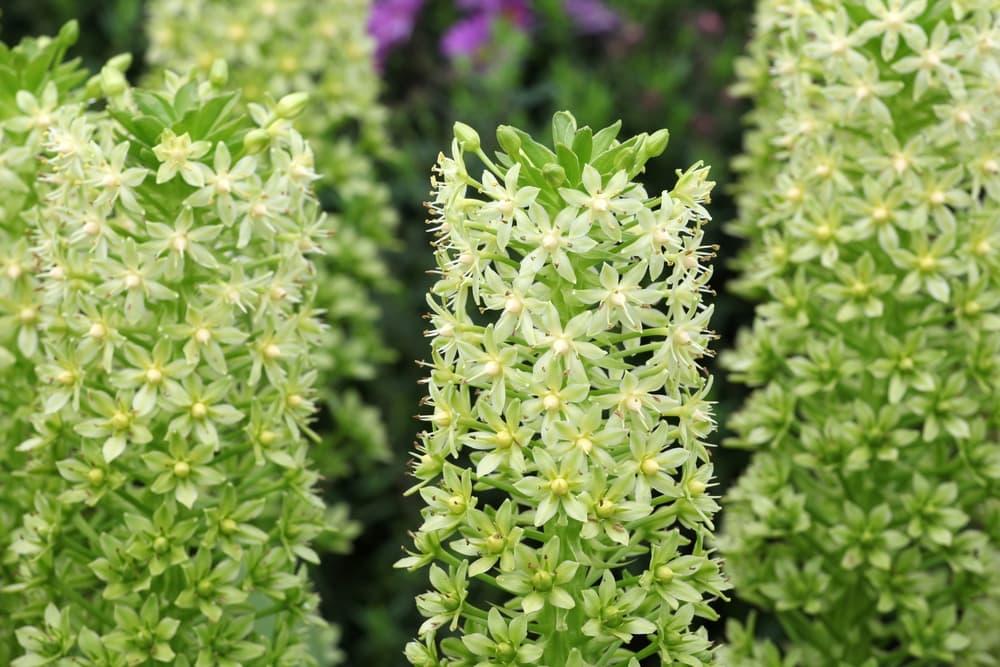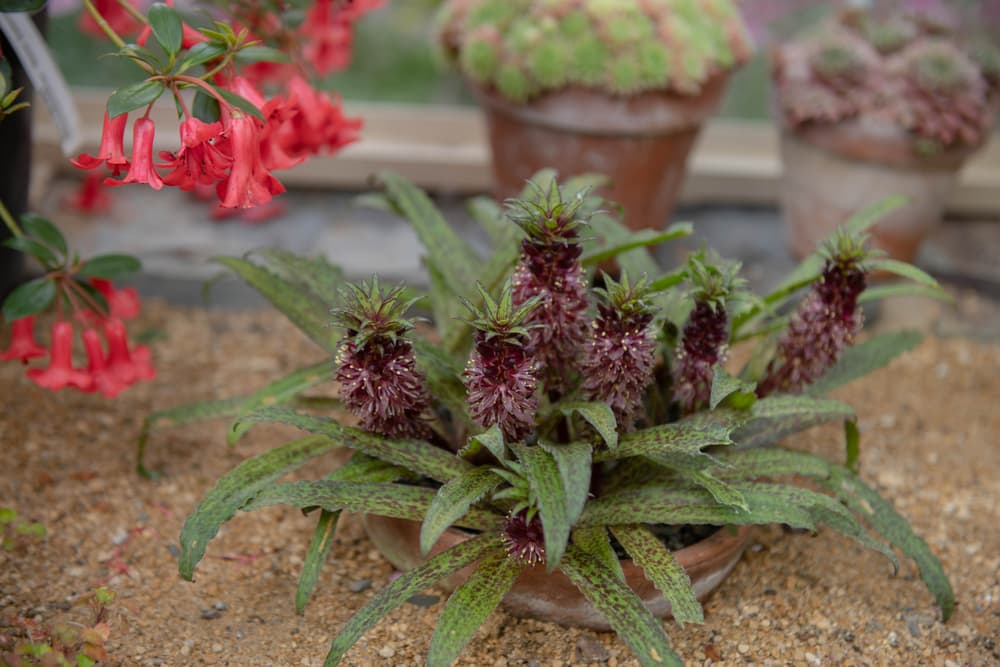BULBS > EUCOMIS
Chris is a gardening writer and nature enthusiast. He graduated from Oxford Brookes University in 2022 with an MA in Psychology. Chris works with the Leeds Green Action Society, helping their food cooperative by growing various fruit and vegetables on their two allotments in Hyde Park, Leeds.
Reviewed By COLIN SKELLY

Colin is a Horticulturist and Horticultural Consultant with experience in a range of practical and managerial roles across heritage, commercial and public horticulture. He holds the Royal Horticultural Society’s Master of Horticulture award and has a particular interest in horticultural ecology and naturalistic planting for habitat and climate resilience.
EUCOMIS GUIDES
Sometimes you see a plant that looks so different that it makes you pause, look carefully, and experience a renewed appreciation for the majesty and boundless creativity of nature.
For me, the pineapple lily does exactly that.
Maybe it’s the tight cylindrical bushel of flowers blooming atop a long, thin stem – or maybe the tuft of thick, almost succulent-looking bracts on top of that.
Whatever it is, it’s hard to argue that this isn’t a striking and captivating plant.
Overview
| Botanical Name | Eucomis |
| Common Name(s) | Pineapple Lilies, Pineapple Flower |
| Plant Type | Perennial Bulb |
| Native Area | South Africa |
| Hardiness Rating | H4 |
| Foliage | Deciduous |
| Flowers | Raceme of small flowers beneath a crown of leafy bracts, which resembles a pineapple |
| When To Sow | March, April, September, October |
| Flowering Months | July, August, September |
Sunlight
Preferred
Full Sun
Exposure
Sheltered
Size
Height
0.1 – 0.5M
Spread
0.1 – 0.5M
Bloom Time
July – September
Soil
Preferred
Chalk, loam, sand
Moisture
Moist but well drained
pH
Any
So if you’re looking for something to grow that will really catch people’s eye, then look no further.
Let’s begin by clarifying that pineapple lilies aren’t pineapples, and the two plants are entirely unrelated.
Eucomis simply takes the common name ‘pineapple lily’ from the fact that its flowers and bracts combine to look a little bit like the tropical fruit.
“Eucomis are fantastic for creating an exotic, even other-worldly, feel to the garden,” shares Colin Skelly, a Master Horticulturist.
“They combine well with other exotic foliage plants or late-summer flowers like Dahlia or Crocosmia.”

The genus Eucomis hails naturally from areas in Southern Africa, but has since become popular amongst gardeners around the world for its interesting aesthetic.1Eucomis. (n.d.). Kew Royal Botanic Gardens. Retrieved March 15, 2023, from https://powo.science.kew.org/taxon/urn:lsid:ipni.org:names:24249-1
Thanks to its exotic appearance and the wide range of colours you’ll find amongst its cultivars, the pineapple lily makes a great addition to any garden looking to move beyond familiar plants and play with faraway themes.
Eucomis Varieties
There are several types of Pineapple Lily, ranging in colour and size.
The purple-white bloom of the bicolor, or the moody red of the E. comosa, or even the hot pink of the ‘Pink Gin’ variety: each brings a different aesthetic and ambience to your garden.

Here are two cultivars (both awarded the RHS AGM for suitability to UK growing) to give an idea of the variety on offer:
Two-Colour Pineapple Lily

Botanical Name: E. bicolor
Bicolor, if you didn’t guess, refers to the two colours this cultivar boasts.
The green leaves around the central rosette erupt into a stunning white-purple in summer, contrasting beautifully against the brown stems that lift the flowers proudly aloft.
This variety likes full sun and will do best in a south, west or east-facing aspect.
It won’t do well in clayey soil, and the ground needs to be able to drain well to promote optimal growth.
While fairly diminutive, the 0.5m taken up by a E. bicolor contains more than enough visual interest to make it worthwhile to grow.
Giant Pineapple Lily

Botanical Name: E. pallidiflora
Given that the bicolor reaches around half a metre in height and width, you might expect the ‘giant’ pineapple lily to weigh in at a couple of metres, at least.
As it happens, though, this cultivar reaches a maximum height of about a metre.
Despite a slightly misleading name, the pallidiflora is a sight to behold.
White flowers burst forth in summer and stick around until autumn, extending the visual interest of this variety beyond some other plants.
As with bicolor, the pallidiflora likes full sun, well-draining soil, and no clay.
It does best in a south- or east-facing aspect, and will take up to five years to reach its full height.
How To Grow Eucomis
Because of its Southern African heritage, Eucomis is used to warmer temperatures than the average UK climate allows for.
With this in mind, it’s important to choose a spot that won’t expose your plant to frosts or cold weather which could harm or even kill it.
If you live in the south of the UK, or abroad in a region with a similar climate, you should be fine planting your pineapple lily directly into the ground, as long as you choose the right spot.

If you live in cooler regions, consider planting out your pineapple lily in a container so that you can move it somewhere warmer (perhaps even indoors) when the cold weather sets in.
Whichever you go for, the right spot should be somewhere that gets full sun, and can drain well.
Make sure you factor in shade from other plants, not just from fences, walls, and similar.
Any shade will threaten the ability of your Eucomis to reach its full bloom potential.
Planting Out
Pineapple lily bulbs need to be planted fairly deep to protect them against frost damage, ideally about 15cm.
Container Growing
Because pineapple lilies can grow fairly high, choose a pot with enough weight and width to remain stable.
A regular flowerpot will be prone to tipping when the plant reaches full height and becomes top-heavy.

Plant bulbs at least 7-8cm apart – any closer than this and they will crowd each other, but you’ve got flexibility in the other direction: bigger gaps will create more spacious displays.
Bulbs don’t need to be as deep in the soil when growing in a container – the tip should be just below the soil surface.
Eucomis Care
Watering
The Eucomis UK growing season spans from April to early October, and the plant must be kept well-watered throughout.

If it dries out your pineapple lily will bloom less enthusiastically and, given that the exotic bloom is one of the main draws of the plant, this outcome is best avoided!
Feeding
For pineapple lilies growing outdoors, fertilising each spring will encourage strong growth.
A general fertiliser will do the trick.
In a container, give your Eucomis a fortnightly dose of liquid feed to keep it healthy.

Check the directions on the packaging to make sure the feed is suitable, and that you’re using the right dose.
Pruning
You’ll be pleased to hear that pineapple lilies don’t need any active pruning.
All you need to do is take off dead leaves, and cut away any messy flower heads.
Overwintering
Eucomis comes from a climate much warmer than ours, where it never has to put up with the sort of temperatures that a UK winter brings.
With this in mind, it’s important to take steps to protect the plant from the cold.
You can leave pineapple lilies in the ground over winter if you live in a southern region of the UK, or somewhere with an equivalent climate.
They’ll need a layer of mulch, about 10cm thick, to keep them as insulated as possible from the frigid elements.

Alternatively, you can carefully pull the plant and bulb from the ground, then store somewhere warmer until next spring.
A greenhouse, shed, or sideboard in your house should do the trick.
If you’re growing in a container, this step is much easier – simply bring the container indoors.
If you stop watering the plant your pineapple lilies will become dormant, patiently waiting for the first glugs of water and sunshine next spring.
Common Problems
We’ve covered the main problems most gardeners encounter already, but let’s quickly recap those before looking at other pests and problems:
Poor Flowering
This can be caused by your pineapple lily getting too much shade, either from structures or other plants, as well as being left dry too often.
Pick a spot in full sun with well-draining soil, and water regularly to avoid this issue.
Winter Damage
This plant needs extra care to keep it warm over winter, as it’s not naturalised to British winter temperatures.
Either cover outdoor bulbs with a thick layer of mulch, or bring containers indoors.
Pests
Just like pretty much every other plant, Eucomis is prone to visitations from slugs, snails, and aphids.
Each of these pests enjoys feasting on your plants, eating their foliage and threatening their ability to thrive.
Physical deterrents can work against slugs or snails: a layer of fleece around the stems, for example.

Or you can plant something sacrificial nearby: a plant such as Nasturtium, designed to attract their attention away from more prized flowers.
With aphids, you have to monitor the plant manually to make sure no small green critters are taking residence on the leaves.
If they do, they’ll suck the sap and cause aesthetic damage or, if left unchecked, leave a more lasting impact on the health of your pineapple lily.
Manually removing aphids and their larvae is one option, and if they continue returning, look for a pesticide to discourage further visits.
Whether you go for a standalone pineapple lily in a container, or you integrate the flower into a more comprehensive display, we assure you that visitors to your garden will turn their heads, captivated by the striking beauty of the plant.
It may feel like a little more work than is required by some other plants, but trust us: It’s well worth it.
References
- 1Eucomis. (n.d.). Kew Royal Botanic Gardens. Retrieved March 15, 2023, from https://powo.science.kew.org/taxon/urn:lsid:ipni.org:names:24249-1

